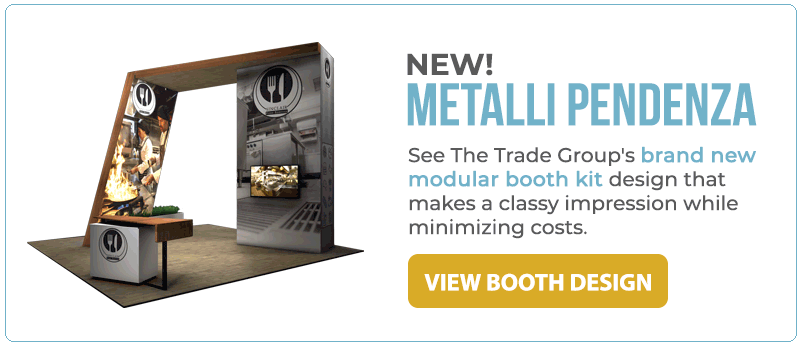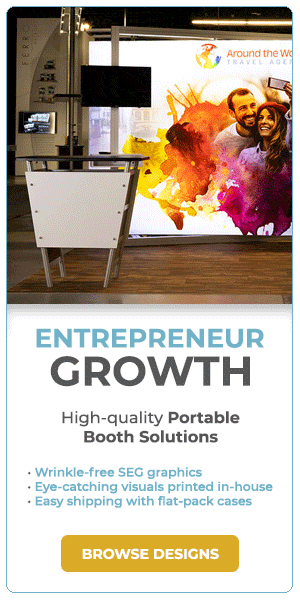
Lindsey is the marketing director at her company. She’s intelligent, hardworking, and knows the ins and outs of conducting digital and event marketing campaigns. As part of her job, she oversees the company’s trade show strategy. Exhibiting at their industry’s largest trade show is expected, but whenever she tries to present a new direction, like an updated exhibit design or strategic giveaway, she gets shot down.
She digs a little deeper to try and find out why. As she pieces it together, she discovers that her managers believe exhibiting at shows is a necessary evil; it’s an expense but also (unfortunately) a must-have. They think that they must attend shows or else…
- They may potentially lose customers to their competitors
- Clients might wonder if everything is OK with the company and panic
- They don’t know what will happen if they don’t attend; after all, they’ve always gone to this industry show
- They could lose valuable insight into the industry and their competitors
In other words, the execs view trade shows as an expense, not an investment. Hence, the discussion about their trade show program revolves around cutting costs rather than how to maximize their return on investment, which means, more often than not, that new ideas get canned.
If you’re in this position, having your ideas and innovations get knocked down by management stuck in the trenches is frustrating, especially if you know they have huge potential.
So, how can you shock the system and be genuinely heard?
Imaginative gridlock
The scenario above is one possible manifestation of imaginative gridlock.
Imaginative gridlock is characterized by trying to find a newer or better answer to an old question. In Edwin H. Friedman’s monumental book, A Failure of Nerve: Leadership in the Age of the Quick Fix, he explains that imaginative gridlock is characterized by “the treadmill of trying harder” in the face of failure. For those stuck in gridlock, failure is believed to be a consequence of not having enough information or the right technique. So, the solution is to innovate by finding a new answer to the same problem. But after a couple more failures, imaginative gridlock begins to set in.
One of the ways to break imaginative gridlock is to abandon the search for innovation and look instead for a paradigm shift. Friedman says that “innovations are new answers to old questions; paradigm shifts reframe the question, change the information that is important, and generally eliminate previous dichotomies” (37). In Lindsey’s case, the only innovations the execs care to hear about are those that answer the question, “how do we cut costs?” An example of a paradigm shift would be to instead ask: “how do we increase our return on investment from the show?” or “why are we continuing to attend a show that doesn’t generate leads and increase revenue?”
Unfortunately, simply asking a new question won’t instantly create a paradigm shift. According to Friedman’s theory, imagination is an emotional, not cognitive, process, which means it’s rooted in relationships. This means the leader’s role has a top-down effect. If the CEO is risk-averse, it will be much more challenging for new ideas (that are genuinely good but involve risk) to receive backing. Employees are rarely able to rise above the maturity level of their managers.
But there may be a way around this. The first step is showing your managers that stagnating is riskier than trying something new. According to the Center for Exhibition Industry Research, roughly 97% of attendees go to shows to discover what’s new in the industry. You might try asking this: How can we expect to attract a crowd to our booth if we’re not helping prospects achieve their goals for the show?
Changing the dichotomies
There are many types of questions, and how you frame the question matters immensely. For example, there are either/or types of questions. When considering purchasing a new exhibit, one possible question to ask is, “will it save us more or cost us more?”
People asking questions based on saving money are making a lateral move at best and are in retreat at worst. A penny saved is a penny earned, goes the saying, except until inflation hits. Then it’s a penny saved is ¾’s a penny earned, and so on and so forth.
Marketing and sales departments founded on saving money are more likely to
- Cut corners
- Compromise on quality
- Make less money
- Stick to the status quo
- Keep trying to improve upon the same old thing
However, if the either/or question is changed to “will it produce more money or less money?” then marketing and sales departments are more likely to
- Find cash cows
- Become thought leaders
- Explore new markets
- Take advantage of new opportunities
- Be more inventive
It’s important to note that asking whether something will produce more money does not necessarily imply spending more money or investing in more assets. The exercise is meant to show how questions significantly influence our mindset and outcomes.
The path to thought leadership
Lindsey’s main challenge with her managers is that they are reactive; they are being dictated to by various sources from the big industry show to their competitors, which forces them to believe they must exhibit at the event—and they drag their feet as they do so.
Lindsey is trying to show them that they don’t merely “have to be there”; they can leverage the show (if indeed it is worth exhibiting at the show) to set themselves up as industry experts by differentiating themselves. This is classic positioning 101. Leaders (and companies) who can make decisions and differentiate themselves are better positioned to be heard long-term.

Conclusion
Looking to set the tone of the conversation at your next show? Work with a team that listens to your brand and believes in your mission. Our award-winning designers and marketing consultants can help set you apart from the competition. Contact us below!
The Trade Group is a full-service trade show and event marketing company. We will work with you to create an exhibit or an event that brings in leads and helps you achieve your business goals. Contact us here or give us a call at (800) 343-2005.
Cameron Wilkinson is a writer and editor in Dallas, TX. His writing for the events industry pairs with his interests in sales and marketing. He also holds a B.A. in English Literature form the University of North Texas.
Photo credit: Pexels




